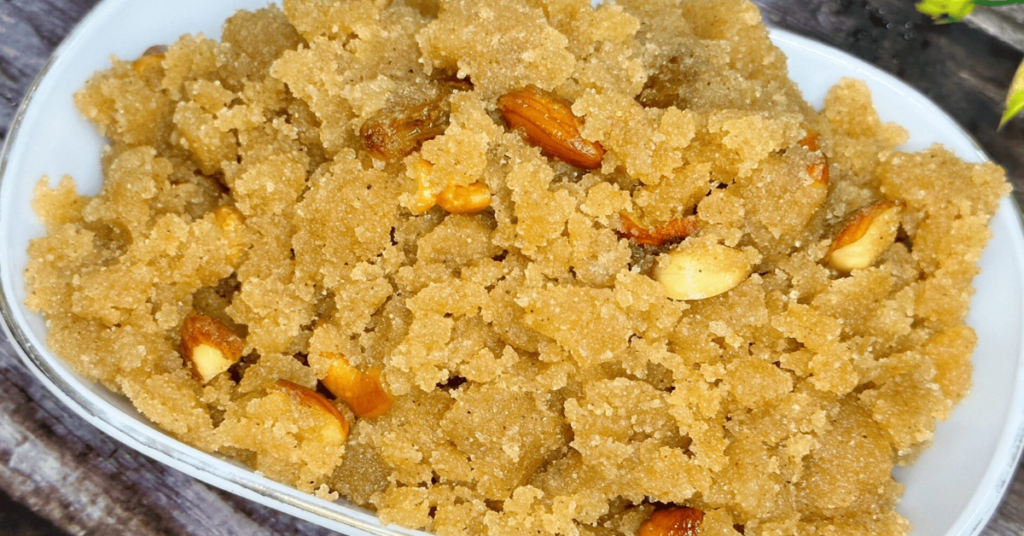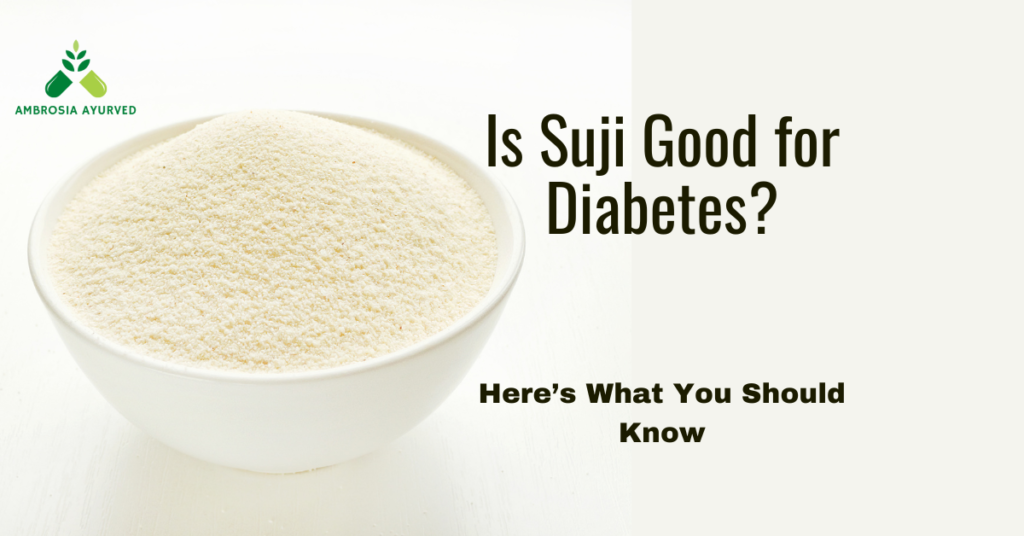Living with diabetes often means watching every ingredient on your plate. Whether you’re cooking at home or eating out, even the most basic foods can raise questions, especially the ones we’ve grown up with. One such ingredient is suji, also known as semolina. It’s used in countless Indian dishes like upma, halwa, and idlis.
But here’s the real question: Is suji good for diabetes?
It’s not a one-word answer. While suji is light, quick to cook, and loved across households, its impact on blood sugar depends on how it’s prepared, portioned, and paired. In this article, we’ll explain everything you need to know — from its glycemic index to how diabetics can include (or avoid) it in their diet.
Let’s clear the confusion once and for all.
What is Suji (Semolina)?
Suji, also known as semolina, is a coarse flour made by grinding durum wheat, a type of hard wheat that is high in protein and gluten. It’s commonly used in Indian kitchens to make dishes like upma, halwa, idlis, and even some types of snacks.
Unlike refined white flour (maida), suji has a slightly coarser texture and retains more of the grain’s natural structure. It’s light, cooks quickly, and adds a mild, nutty flavor to meals.
Nutritionally, suji is a good source of carbohydrates and contains small amounts of protein, iron, and B vitamins. However, it’s relatively low in fiber unless combined with vegetables or other high-fiber ingredients.
Because of its high carb content, many people wonder — is suji safe for diabetic patients? The answer depends on several factors, which we’ll explore in the next sections.
Glycemic Index of Suji and Its Role in Diabetes
To understand whether suji is good for diabetes, it helps to look at its Glycemic Index (GI). The GI is a number that tells us how quickly a food can raise blood sugar levels. Foods with a high GI (above 70) cause sugar spikes, while those with a low GI (below 55) are digested slowly, keeping sugar levels more stable.
Now, where does suji (semolina) fall?
Suji usually has a moderate to high glycemic index, typically between 60 and 70. This means it can cause a noticeable rise in blood sugar, especially if eaten in large quantities or in unhealthy forms like halwa or fried snacks. That’s because suji is a refined grain and digests faster than whole grains, which isn’t ideal for someone managing diabetes.
However, it’s not all bad. The way you prepare and pair suji matters a lot. If you cook it with fiber-rich vegetables, or eat it with a source of protein like curd, dal, or paneer, it slows down digestion and reduces the sugar spike. Even portion control can make a big difference.
So in short, suji isn’t something that must be completely avoided — but if you’re diabetic, it’s better to limit it, and whenever possible, replace it with lower-GI grains like oats, barley, or millets for better blood sugar control.

Can Diabetics Eat Suji? Pros and Cons
When it comes to diabetes, there’s rarely a one-size-fits-all answer — and suji (semolina) is no exception. While some diabetic patients may tolerate it well in moderation, others might experience sugar spikes depending on how it’s prepared.
Let’s break down the pros and cons of eating suji for diabetic patients:
✅ Pros of Suji for Diabetics:
- Quick source of energy: Suji provides complex carbs, which offer a quick energy boost — helpful if paired with a balanced meal.
- Easy to digest: It’s light on the stomach and doesn’t cause bloating.
- Versatile in recipes: Can be combined with vegetables, pulses, or yogurt to make it healthier.
❌ Cons of Suji for Diabetics:
- Moderate glycemic index: Suji can raise blood sugar levels if eaten in large amounts or without balance.
- Low in fiber: Refined suji lacks natural fiber, which slows down sugar absorption.
- Often cooked unhealthily: Suji dishes like halwa are loaded with sugar and ghee, making them a poor choice for diabetics.
Best Ways to Eat Suji If You’re Diabetic
If you have diabetes but still enjoy the occasional suji dish, the good news is — you don’t have to give it up completely. With a few smart tweaks, suji can fit into your diet in a more balanced way.
Here are some of the best ways diabetics can include suji in their meals:
🍽️ 1. Choose Steamed or Lightly Cooked Dishes
Stick to recipes like suji upma or idlis, which use less oil and no sugar. Wondering if upma is good for diabetes? Yes — especially when it’s packed with veggies and not overloaded with ghee.
🥦 2. Add Fiber-Rich Ingredients
Toss in vegetables like carrots, beans, spinach, or peas. Fiber slows down digestion and helps avoid sugar spikes.
🥣 3. Pair with Protein
Serve suji dishes with curd, boiled eggs, or dal to balance your plate.
⏱️ 4. Practice Portion Control
One small serving is enough. Don’t make suji the star of your meal — treat it as a side.
Alternatives to Suji for Diabetics

If you’re living with diabetes and want to reduce your intake of suji, you’ve got some healthy and tasty options. These healthy alternatives to suji are easier on your blood sugar levels and often higher in fiber, making them more diabetes-friendly.
🟡 1. Oats
Rich in soluble fiber, oats are a great breakfast base. They digest slowly, keeping sugar levels stable.
🟢 2. Poha (Flattened Rice)
Yes, poha is a popular and diabetes-friendly alternative to suji, especially when cooked with vegetables and minimal oil. Curious to know more? Check out our detailed article:
👉 Is Poha Good for Diabetics?
🟠 3. Broken Wheat (Dalia)
Also called lapsi, dalia is rich in fiber and has a lower glycemic index than suji. Ideal for khichdi or porridge-style dishes.
🔵 4. Ragi (Finger Millet)
Packed with calcium and fiber, ragi is perfect for diabetic-friendly dosas, rotis, and laddoos.
Final Verdict: Is Suji Good for Diabetes?
So, is suji good for diabetes? The answer isn’t a strict yes or no — it’s all about balance, preparation, and portion.
Suji can be included in a diabetic diet occasionally, especially when it’s cooked with minimal oil, no sugar, and paired with fiber or protein. Dishes like upma with vegetables or steamed suji idlis are better options than sugary halwa or deep-fried snacks.
That said, suji is still a refined grain with a moderate glycemic index, so it’s best to avoid eating it daily. If you’re looking for safer, more diabetes-friendly options, poha, oats, ragi, and dalia are worth considering.
As always, listen to your body and consult your doctor or nutritionist if you’re unsure. What works for one diabetic might not suit another.
Enjoy suji occasionally and wisely — but don’t make it a staple.
FAQ
Can diabetics eat suji daily?
Not recommended. Occasional consumption in small quantities is fine.
Is upma made from suji good for diabetics?
Yes, if made with minimal oil and lots of vegetables.
Is suji better than rice for diabetics?
Both have similar GI. Brown rice or millets are usually better options.
Can suji spike blood sugar levels?
Yes, if eaten alone or in large portions.
What’s a healthier alternative to suji for diabetics?
Try millets, oats, or quinoa for a better glycemic response.




